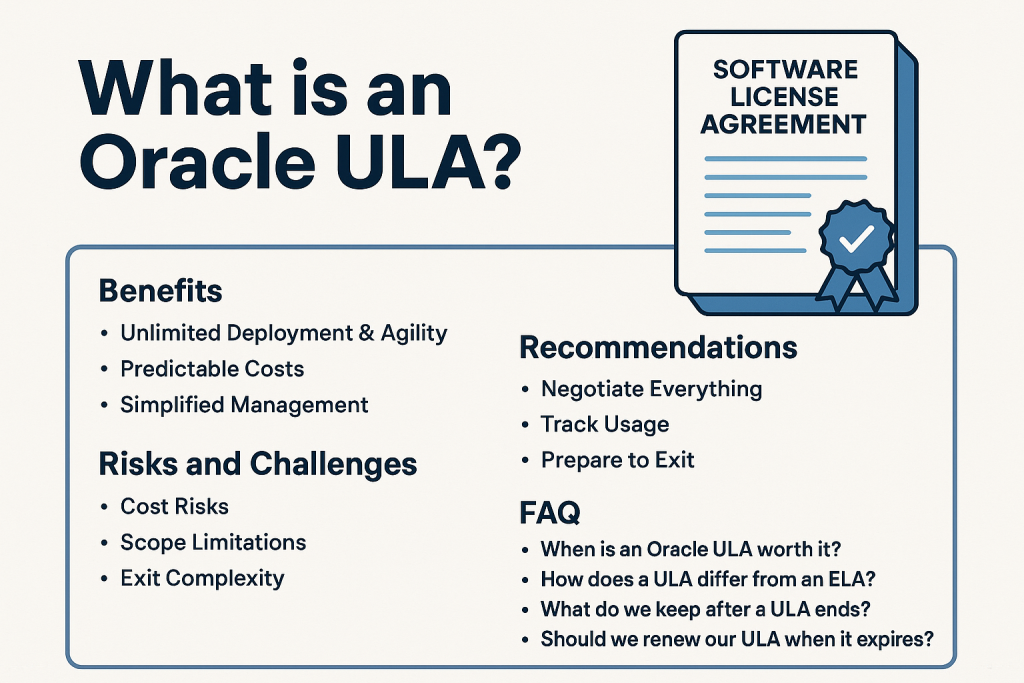
What is an Oracle ULA?
An Oracle ULA (Unlimited License Agreement) is an Oracle contract that grants unlimited use of specific Oracle software for a fixed term (usually 3 years) in exchange for a large upfront fee plus a fixed annual support cost.
It can provide flexibility and cost predictability for fast-growing Oracle environments, but it also carries significant risks, which must be negotiated and managed carefully to avoid pitfalls.
Understanding the Oracle ULA
An Oracle ULA is essentially an “all-you-can-eat” licensing deal for certain Oracle software.
The customer pays a one-time upfront fee (often millions of dollars) to get unlimited deployment rights for specific Oracle products listed in the ULA contract, over a defined term (usually 3 years).
During that period, you can deploy as many instances of those products as needed without counting licenses.
The contract defines exactly which products are covered under the agreement. On top of that, you pay an annual support fee (about 22% of the license fee) during the term.
At the end of the ULA term, the customer must either certify its usage (report how many installations are in use and keep that number of licenses) or negotiate a renewal of the ULA for another term.
Benefits of an Oracle ULA
- Unlimited Deployment & Agility: Freedom to deploy as many instances of the covered Oracle products as needed, without license procurement delays. This allows rapid expansion and quick scaling for new projects or initiatives.
- Predictable Costs: A fixed up-front cost and set support fee provide budget certainty. If usage grows massively, this can save money versus buying licenses gradually.
- Simplified Management: All covered software falls under one agreement. You don’t need to track individual license counts or constantly request new licenses during the term, reducing administrative overhead and audit worries.
Risks and Challenges
- Cost Risks: If you overestimate usage, you may pay for capacity you never needed, and the big upfront fee plus ongoing support can be wasted. Also, the annual support (22% of the contract value) becomes a locked-in expense that continues even after the ULA, making it hard to reduce costs later.
- Scope Limitations: The ULA covers only the products (and entities) explicitly listed. Using any Oracle product or option not in the agreement is not licensed and can trigger compliance issues. “Unlimited” doesn’t apply to everything Oracle sells – just the products named in your ULA.
- Exit Complexity: At term end, counting every installation for certification is a complex task. Mistakes or overlooked instances can leave you under-licensed after the ULA.
A company’s Oracle support bill increased from $1M to $2.1M per year after entering a ULA, establishing a higher support baseline for the future.
Recommendations
- Negotiate Everything: Make sure all required products, options, and entities are included in the ULA contract (including cloud use if needed). Try to cap support fee increases.
- Track Usage: Continuously monitor Oracle deployments during the ULA to avoid using anything outside the agreement and to simplify end-of-term counting.
- Prepare to Exit: Audit and clean up your Oracle environment well in advance of ULA expiration. Document all instances so you can accurately certify or negotiate effectively at term end.
- Don’t Default to Renew: When the term ends, compare the costs of renewing versus certifying and using the licenses you’ve gained. Often, exiting (and buying a few extra licenses if needed) is cheaper. Renew only if you truly anticipate another massive growth that justifies it.
Checklist
- Forecast Needs: Review current Oracle usage and multi-year growth plans to confirm a ULA is justified.
- Define Scope: List all Oracle products (and add-ons) and business units that must be covered; ensure the contract includes them.
- Assign Governance: Designate a team or owner to monitor Oracle deployments and prevent out-of-scope usage during the ULA term.
- Audit Before Exit: Inventory and document all Oracle installations well before the ULA end date to ensure nothing is missed during certification.
- Plan End-of-Term Decision: Decide in advance if you will certify or renew. Don’t let the deadline force a rushed choice – weigh your options with time to spare.
FAQ
Q1: When is an Oracle ULA worth it?
A: A ULA is most worthwhile if you’re expecting explosive growth in usage or need to resolve a large compliance shortfall; it’s usually not cost-effective for steady or small-scale usage.
Q2: How does a ULA differ from an ELA?
A: A ULA gives unlimited use of specified products for a limited term (then you certify usage to keep licenses), whereas an ELA is a one-time purchase of a fixed number of licenses that you own outright.
Q3: What do we keep after a ULA ends?
A: You keep perpetual licenses equal to the usage you certify at the end of the term. Any deployments not certified are not licensed once the ULA expires.
Q4: Can a ULA cover cloud or virtualization?
A: Yes, if you negotiate it. Make sure the ULA contract explicitly covers your use of Oracle in public clouds (AWS, Azure, etc.) and on virtualized platforms (like VMware); otherwise, those might not count under your unlimited use rights.
Q5: Should we renew our ULA when it expires?
A: First, determine how many licenses you’d have by certifying your current usage, and if that meets your needs. Only renew if you truly expect another surge in Oracle usage – even then, negotiate the terms aggressively.
Read about our Oracle ULA License Optimization Service.